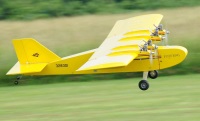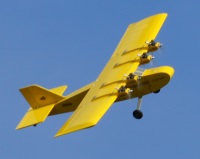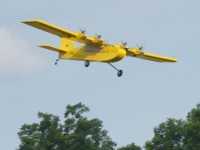


 |
 |
 |
The Flying King is a single engine trainer designed and produced by Bruce Tharpe.....of Bruce Tharpe Engineering (BTE Models). The model handles a range of engines from a .60 to .90 CI. It has a wing span of 80 inches and weighs 10 pounds.
I'm interested in building a B-17 model with a 10 foot wing span. I thought it would be wise to build a smaller four engine model to practice with. I selected the Flying King because of its size and particularly its large wing. I thought the large wing could handle the addition of four engines without much redesigning. The nacelles were spaced along the wing to provide clearance for APC 9X6 propellers. I already owned four OS.20 size four cycle engines. It was necessary to increase the wing span one inch to accommodate the propellers, with 1/4 inch separation between the propeller tips. The nacelles were designed to house the engine, a 3 ounce fuel tank, and a throttle servo. 3/32 inch light ply was used for the nacelle sides, and 1/8 balsa on the top and bottom. A 3/16 inch plywood firewall was used for the engine mount. The nacelles fit between two ribs. The area on each side of the nacelles are sheeted. The Leading Edge was cut to allow the nacelle to fit, but the wing spars remain un-cut. The shape of the nacelle was completely arbitrary.
The fuselage wing mount area was sheeted with 1/8 inch balsa for additional strength. 1/2 inch tri-stock was added vertically to stiffen the existing formers. The nose was sheeted to cover the open space of the single engine location. Nothing else was done to the fuselage.
All servo wires are routed through the existing paper tube in the wing. The remaining portions of the model were completed per instructions. The proper CG was obtained by placing the battery in the nose area. It was necessary to add 1/4 inch to the elevator travel, and increase the rudder throw 1/2 inch. Ailerons have recommended throws. The plane is covered with Yellow Monokote, with red and blue trim.
The first flight was short due to the number one engine (left) quitting shortly after takeoff. That engine continued to cause problems until I determined the throttle linkage was not properly fastened. Once that was corrected, all the engines performed without further problems. I have the carburetor mixture fairly rich. The rich mixture will permit the engines to remain rich throughout the flight regardless of fuel tank level.
 |
 |
 |
 |
The performance of the model is not as good as a single engine powered plane. The plane is fun to fly though, with the unique sound from the four engines being the highlight. I noticed the torque from the four engines is very noticeable. Coordinated turns are a must, one of the reasons for the increased rudder travel. Landings require a little power to over come drag...until ready to flair for landing.
As for my goal of using it to learn to fly a four engine model, it has been a complete success. Learning to manage the four engines so they remain running during flight has been a crucial step. Also, the planning required to modify a model for multi engines is very helpful for future projects. I would recommend this kind of modification to others. Flying the model is easy...that is mostly the choice in airframe. The Flying King is an excellent flying model and adding four engines didn't change that.
Keith